Optimizing Dam Detection in Large Areas: A Hybrid RF-YOLOv11 Framework with Candidate Area Delineation
Abstract
1. Introduction
2. Data and Methods
2.1. Study Area
2.2. Data Sources and Pre-Processing
2.2.1. Terrain Data
2.2.2. Hydrological Data
2.2.3. OSM Hydrographic Vector Data
2.2.4. Dam Image Sample Set
2.3. Methodologies
2.3.1. Dam Candidate Area Classification Model
2.3.2. Screening Strategy for Dam Candidate Area Imagery
2.3.3. YOLOv11 Dam Identification Model
3. Results and Analysis
3.1. Dam Existence Probability Distribution Results
3.2. Dam Existence Probability Distribution Accuracy Analysis
3.3. Accuracy Evaluation of Dam Recognition Model
3.4. Comparative Analysis of the Hybrid Framework
3.4.1. Performance of YOLOv11 Before and After RF Filtering
3.4.2. Novelty of the Hybrid Framework Compared to Existing Methods
3.5. Dam Identification Results and Analysis
4. Discussion
5. Conclusions
Author Contributions
Funding
Acknowledgments
Conflicts of Interest
References
- Maavara, T.; Chen, Q.; Van Meter, K.; Brown, L.E.; Zhang, J.; Ni, J.; Zarfl, C. River dam impacts on biogeochemical cycling. Nat. Rev. Earth Environ. 2020, 1, 103–116. [Google Scholar] [CrossRef]
- Gupta, A.D.; Pandey, P.; Feijóo, A.; Yaseen, Z.M.; Bokde, N.D. Smart Water Technology for Efficient Water Resource Management: A Review. Energies 2020, 13, 6268. [Google Scholar] [CrossRef]
- Mulligan, M.; van Soesbergen, A.; Sáenz, L. GOODD, a global dataset of more than 38,000 georeferenced dams. Sci. Data 2020, 7, 31. [Google Scholar] [CrossRef] [PubMed]
- Lehner, B.; Beames, P.; Mulligan, M.; Zarfl, C.; De Felice, L.; van Soesbergen, A.; Thieme, M.; Garcia de Leaniz, C.; Anand, M.; Belletti, B.; et al. The Global Dam Watch database of river barrier and reservoir information for large-scale applications. Sci. Data 2024, 11, 1069. [Google Scholar] [CrossRef]
- Zarfl, C.; Lumsdon, A.E.; Berlekamp, J.; Tydecks, L.; Tockner, K. A global boom in hydropower dam construction. Aquat. Sci. 2015, 77, 161–170. [Google Scholar] [CrossRef]
- Mulligan, M.; Lehner, B.; Zarfl, C.; Thieme, M.; Beames, P.; van Soesbergen, A.; Higgins, J.; Januchowski-Hartley, S.R.; Brauman, K.A.; De Felice, L. Global Dam Watch: Curated data and tools for management and decision making. Environ. Res. Infrastruct. Sustain. 2021, 1, 033003. [Google Scholar] [CrossRef]
- Zhang, X.; Huang, J.; Ning, T. Progress and Prospect of Cultivated Land Extraction from High-Resolution Remote Sensing Images. Geomat. Inf. Sci. Wuhan Univ. 2023, 48, 1582–1590. [Google Scholar] [CrossRef]
- Wang, W.; Li, B.; Chen, B. Improved surface NO2 Retrieval: Double-layer machine learning model construction and spatio-temporal characterization analysis in China (2018–2023). J. Environ. Manag. 2025, 384, 125439. [Google Scholar] [CrossRef]
- Han, G.; Huang, Y.; Shi, T.; Zhang, H.; Li, S.; Zhang, H.; Chen, W.; Liu, J.; Gong, W. Quantifying CO2 emissions of power plants with Aerosols and Carbon Dioxide Lidar onboard DQ-1. Remote Sens. Environ. 2024, 313, 114368. [Google Scholar] [CrossRef]
- Li, H.; Liu, B.; Gong, W.; Ma, Y.; Jin, S.; Wang, W.; Fan, R.; Jiang, S. Influence of clouds on planetary boundary layer height: A comparative study and factors analysis. Atmos. Res. 2025, 314, 107784. [Google Scholar] [CrossRef]
- Yang, J.; Gan, R.; Luo, B.; Wang, A.; Shi, S.; Du, L. An Improved Method for Individual Tree Segmentation in Complex Urban Scenes Based on Using Multispectral LiDAR by Deep Learning. IEEE J. Sel. Top. Appl. Earth Obs. Remote Sens. 2024, 17, 6561–6576. [Google Scholar] [CrossRef]
- Sun, J.; Lucas, M.C.; Olden, J.D.; Couto, T.B.A.; Ning, N.; Duffy, D.; Baumgartner, L.J. Towards a comprehensive river barrier mapping solution to support environmental management. Nat. Water 2025, 3, 38–48. [Google Scholar] [CrossRef]
- Wang, Y.; Tian, Y.; Cao, Y. Dam Siting: A Review. Water 2021, 13, 2080. [Google Scholar] [CrossRef]
- Zhang, Z. Research on Automatic Extraction of Typical Water Conservancy Elements. Ph.D. Thesis, Wuhan University, Wuhan, China, 2019. [Google Scholar]
- Wang, L.; Xu, Y.; Chen, Q.; Wu, J.; Luo, J.; Li, X.; Peng, R.; Li, J. Research on Remote-Sensing Identification Method of Typical Disaster-Bearing Body Based on Deep Learning and Spatial Constraint Strategy. Remote Sens. 2024, 16, 1161. [Google Scholar] [CrossRef]
- Ran, Z. Fast Recognition of Bridge and Dam in Complex Background Through Large-Scale Data. Master’s Thesis, University of Electronic Science and Technology of China, Chengdu, China, 2015. [Google Scholar]
- Jing, M.; Cheng, L.; Ji, C.; Mao, J.; Li, N.; Duan, Z.; Li, Z.; Li, M. Detecting unknown dams from high-resolution remote sensing images: A deep learning and spatial analysis approach. Int. J. Appl. Earth Obs. Geoinf. 2021, 104, 102576. [Google Scholar] [CrossRef]
- Jing, Y. Study on Intelligent Detection of Dam and Extraction of Dam Damage Caused by Disaster Based on High-Resolution lmagery. Master’s Thesis, University of Chinese Academy of Sciences, Beijing, China, 2022. [Google Scholar]
- Xu, Z.; Shen, Z.; Li, Y.; Li, J.; Wang, H.; Li, S.; Jiao, S.; Li, L. Detection of water conservancy facilities in large-format image combining E-YOLO algorithm and NDWI constraint. Natl. Remote Sens. Bull. 2022, 26, 2083–2093. [Google Scholar] [CrossRef]
- Nanditha, J.; Kushwaha, A.P.; Singh, R.; Malik, I.; Solanki, H.; Chuphal, D.S.; Dangar, S.; Mahto, S.S.; Vegad, U.; Mishra, V. The Pakistan flood of August 2022: Causes and implications. Earth’s Future 2023, 11, e2022EF003230. [Google Scholar] [CrossRef]
- Farr, T.G.; Rosen, P.A.; Caro, E.; Crippen, R.; Duren, R.; Hensley, S.; Kobrick, M.; Paller, M.; Rodriguez, E.; Roth, L. The shuttle radar topography mission. Rev. Geophys. 2007, 45. [Google Scholar] [CrossRef]
- Riley, S.J.; DeGloria, S.D.; Elliot, R. Index that quantifies topographic heterogeneity. Intermt. J. Sci. 1999, 5, 23–27. [Google Scholar]
- Lehner, B.; Verdin, K.; Jarvis, A. New global hydrography derived from spaceborne elevation data. Eos Trans. Am. Geophys. Union 2008, 89, 93–94. [Google Scholar] [CrossRef]
- McDonnell, J.J.; Sivapalan, M.; Vaché, K.; Dunn, S.; Grant, G.; Haggerty, R.; Hinz, C.; Hooper, R.; Kirchner, J.; Roderick, M. Moving beyond heterogeneity and process complexity: A new vision for watershed hydrology. Water Resour. Res. 2007, 43. [Google Scholar] [CrossRef]
- Bartier, P.M.; Keller, C.P. Multivariate interpolation to incorporate thematic surface data using inverse distance weighting (IDW). Comput. Geosci. 1996, 22, 795–799. [Google Scholar] [CrossRef]
- Wu, J.; Li, W.; Du, H.; Wan, Y.; Yang, S.; Xiao, Y. An annotated satellite imagery dataset for automated river barrier object detection. Sci. Data 2025, 12, 237. [Google Scholar] [CrossRef] [PubMed]
- Soares, L.P.; Dias, H.C.; Grohmann, C.H. Landslide segmentation with U-Net: Evaluating different sampling methods and patch sizes. arXiv 2020, arXiv:2007.06672. [Google Scholar] [CrossRef]
- Haddad, R.A.; Akansu, A.N. A class of fast Gaussian binomial filters for speech and image processing. IEEE Trans. Signal Process. 1991, 39, 723–727. [Google Scholar] [CrossRef]
- Barbu, T. Variational Image Denoising Approach with Diffusion Porous Media Flow. Abstract and Applied Analysis. 2013, p. 856876. Available online: https://onlinelibrary.wiley.com/doi/10.1155/2013/856876 (accessed on 31 August 2025).
- Genuer, R.; Poggi, J.-M. Random Forests. In Random Forests with R; Genuer, R., Poggi, J.-M., Eds.; Springer International Publishing: Cham, Switzerland, 2020; pp. 33–55. [Google Scholar]
- Iverson, L.R.; Prasad, A.M.; Matthews, S.N.; Peters, M. Estimating potential habitat for 134 eastern US tree species under six climate scenarios. For. Ecol. Manag. 2008, 254, 390–406. [Google Scholar] [CrossRef]
- Ahmed, M.; Seraj, R.; Islam, S.M. The k-means Algorithm: A Comprehensive Survey and Performance Evaluation. Electronics 2020, 9, 1295. [Google Scholar] [CrossRef]
- Khanam, R.; Hussain, M. Yolov11: An overview of the key architectural enhancements. arXiv 2024, arXiv:2410.17725. [Google Scholar] [CrossRef]
- Nikhil, S.; Danumah, J.H.; Saha, S.; Prasad, M.K.; Rajaneesh, A.; Mammen, P.C.; Ajin, R.S.; Kuriakose, S.L. Application of GIS and AHP Method in Forest Fire Risk Zone Mapping: A Study of the Parambikulam Tiger Reserve, Kerala, India. J. Geovisualization Spat. Anal. 2021, 5, 14. [Google Scholar] [CrossRef]
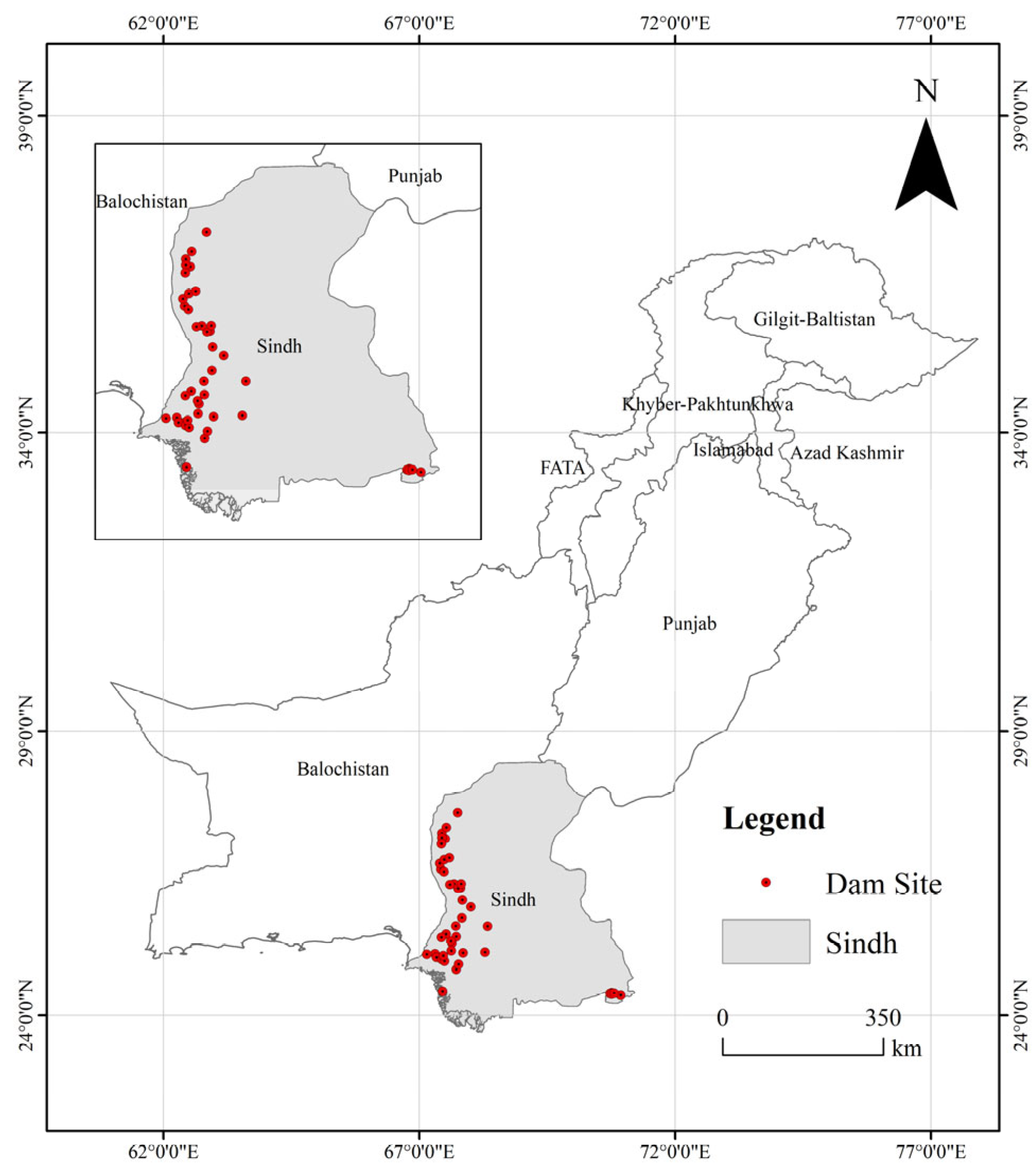
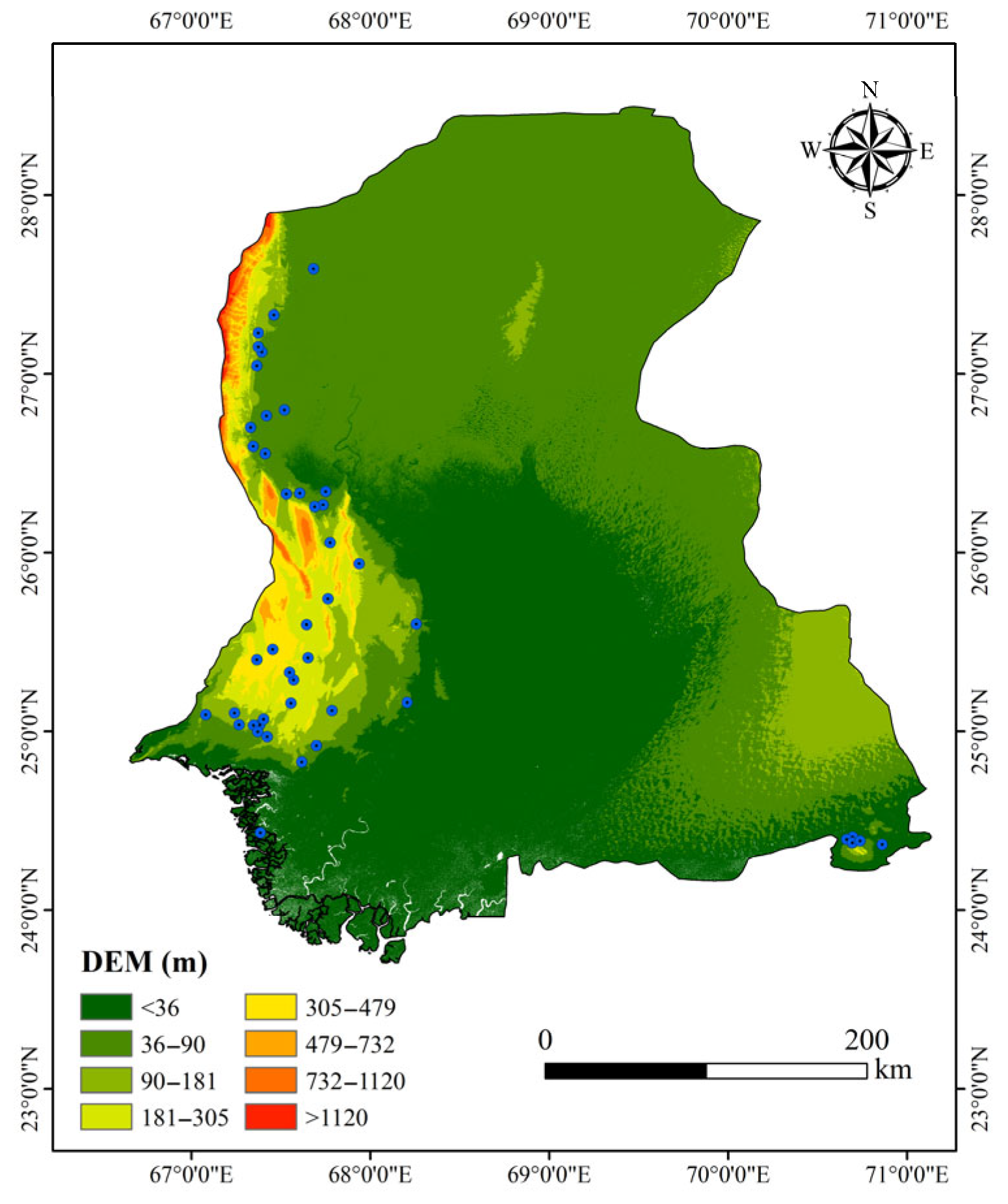

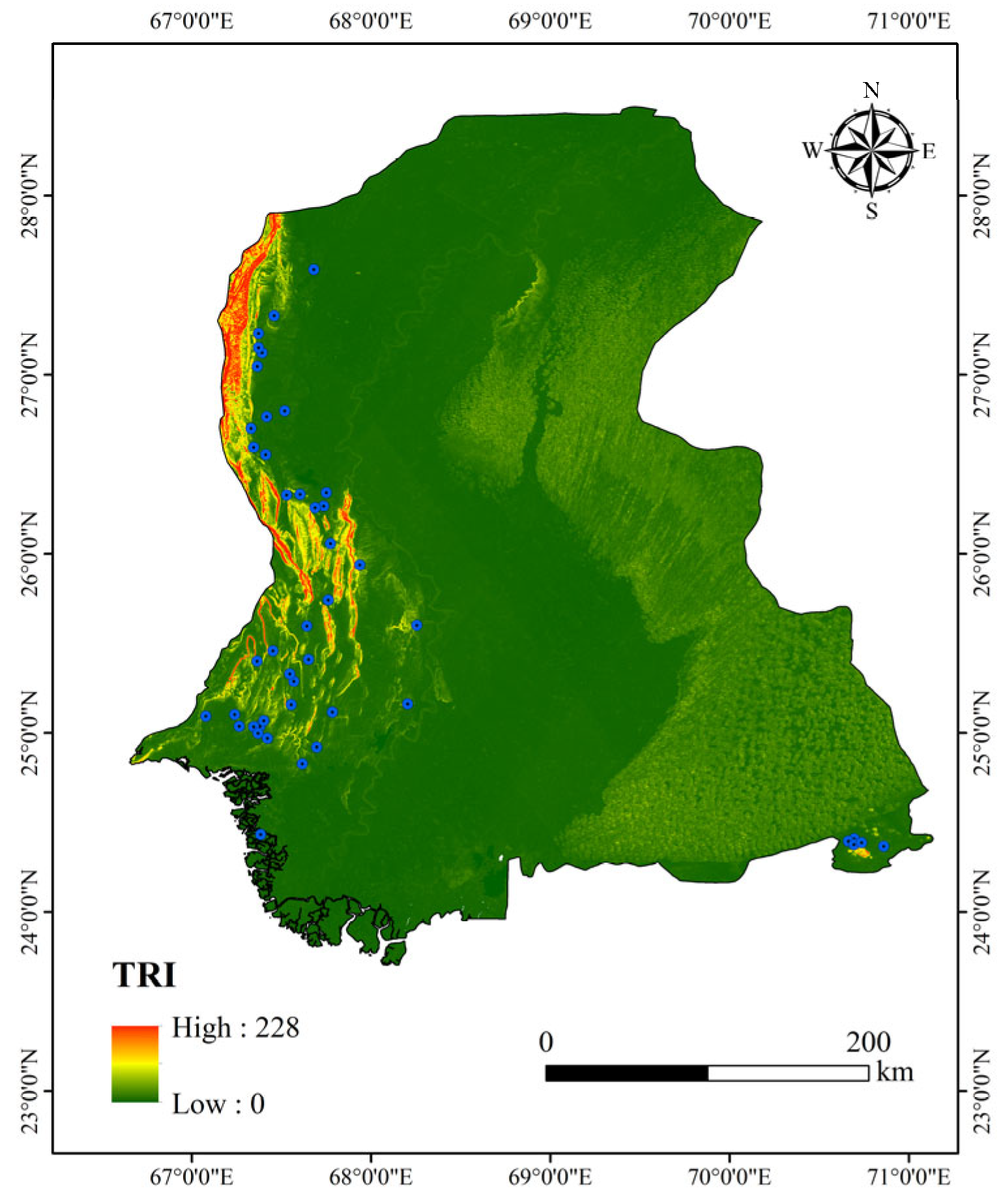
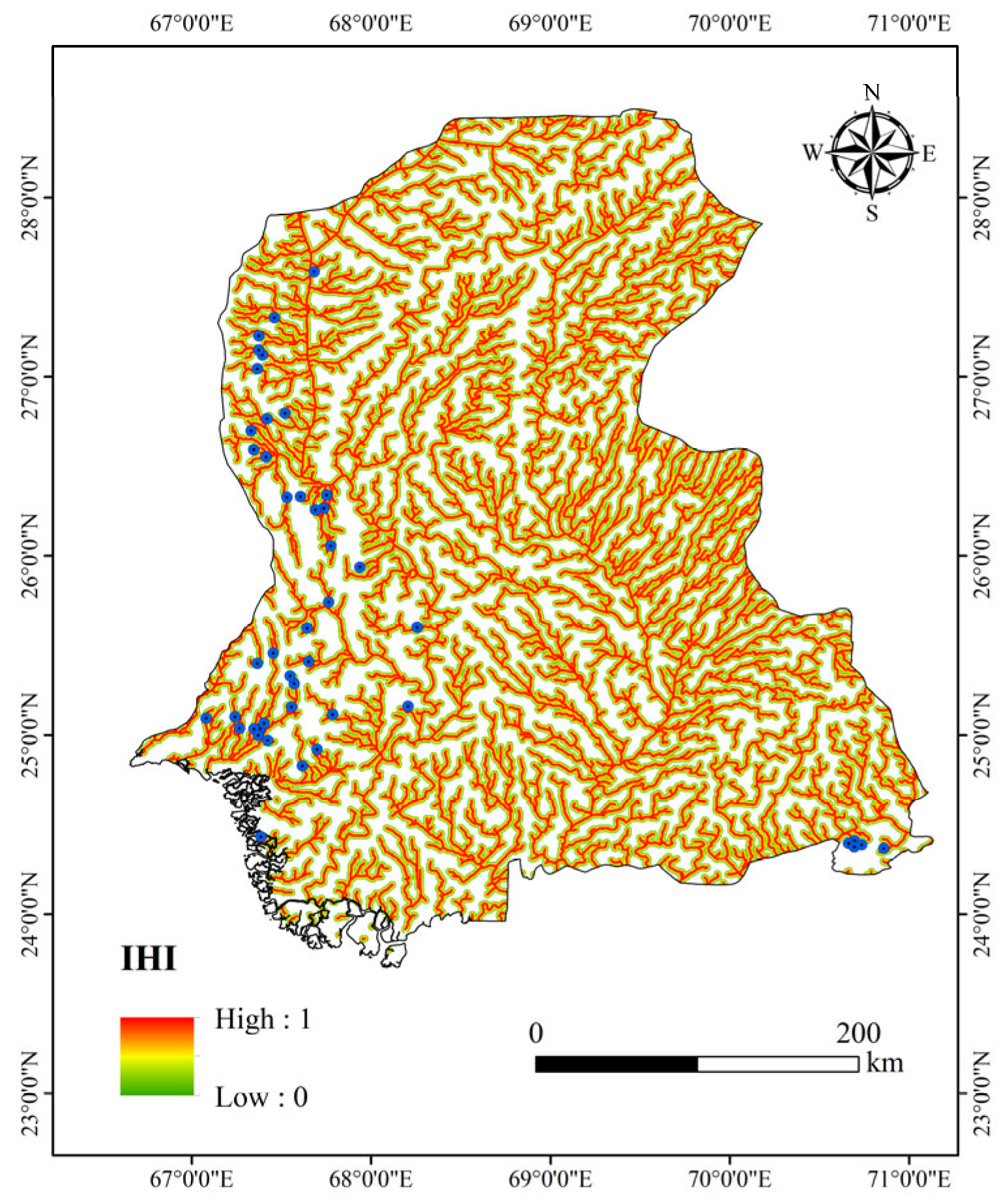
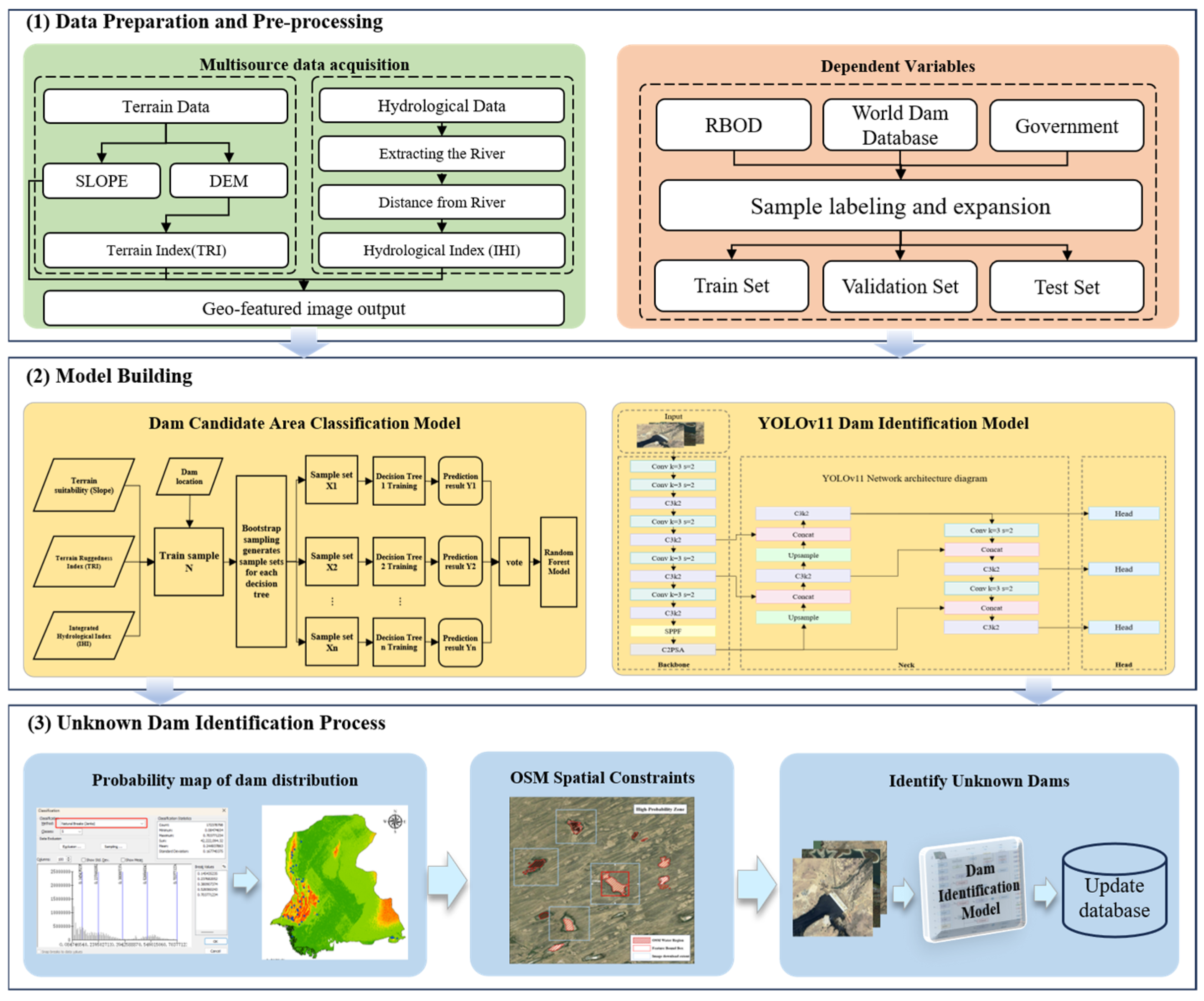



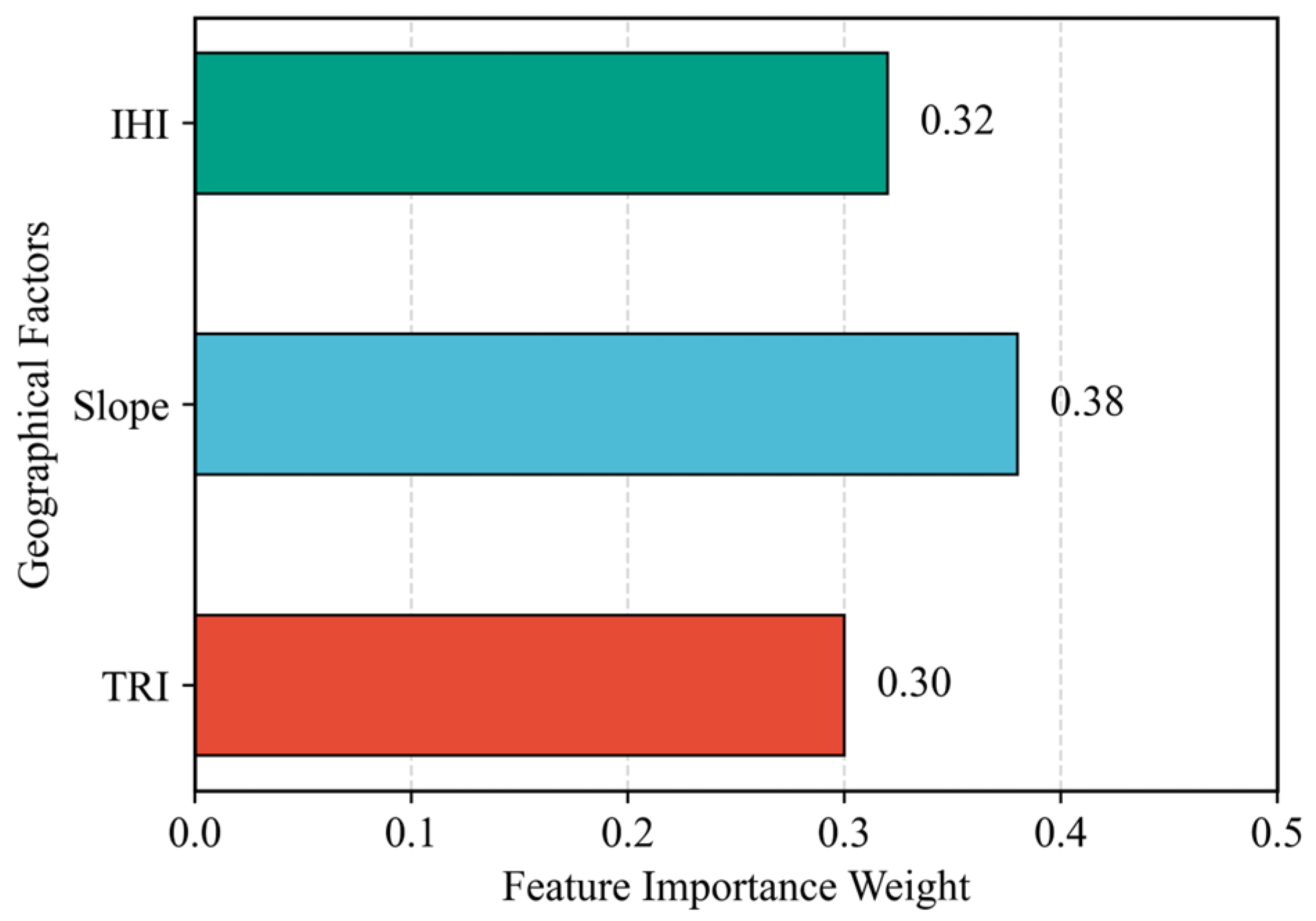
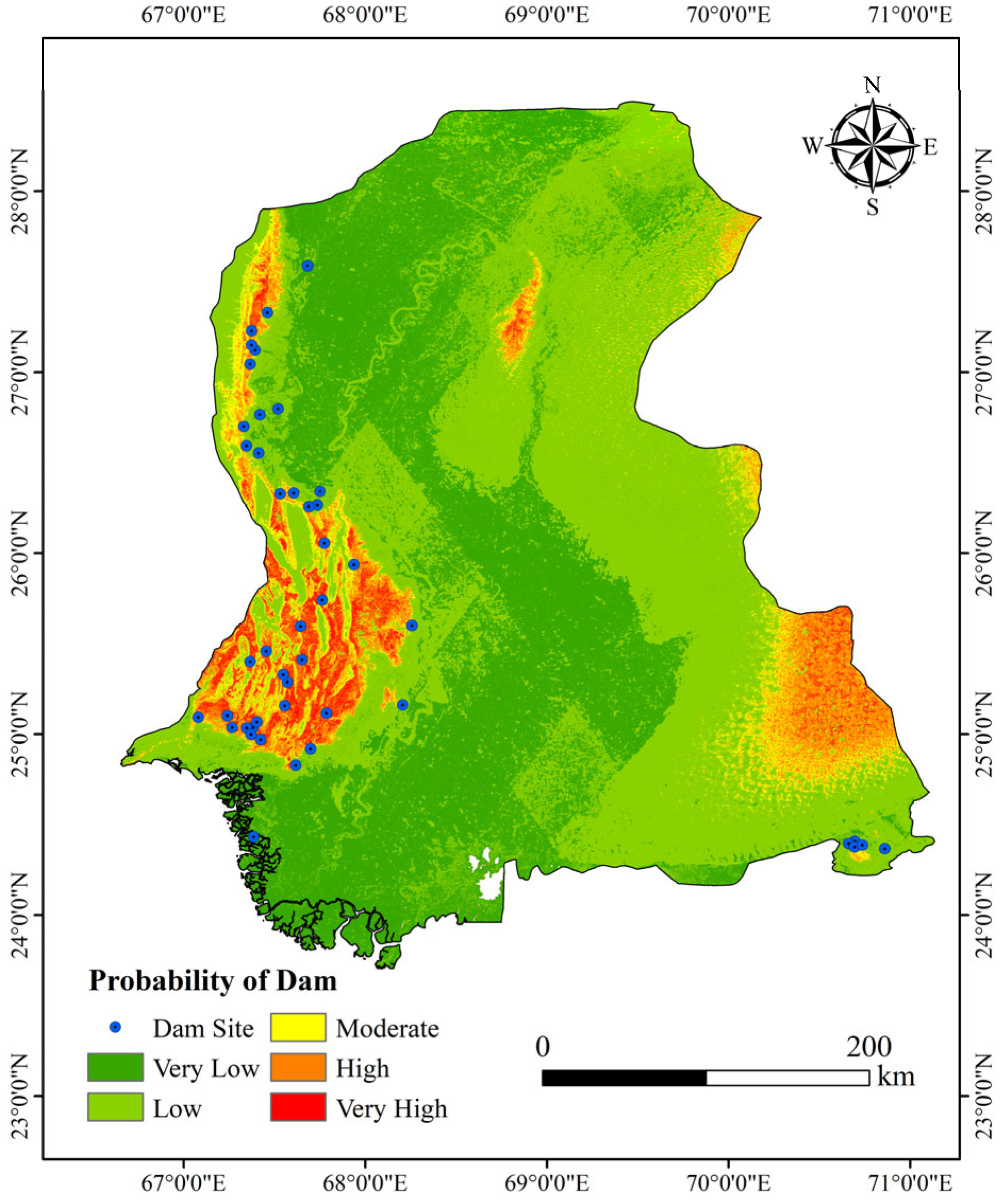
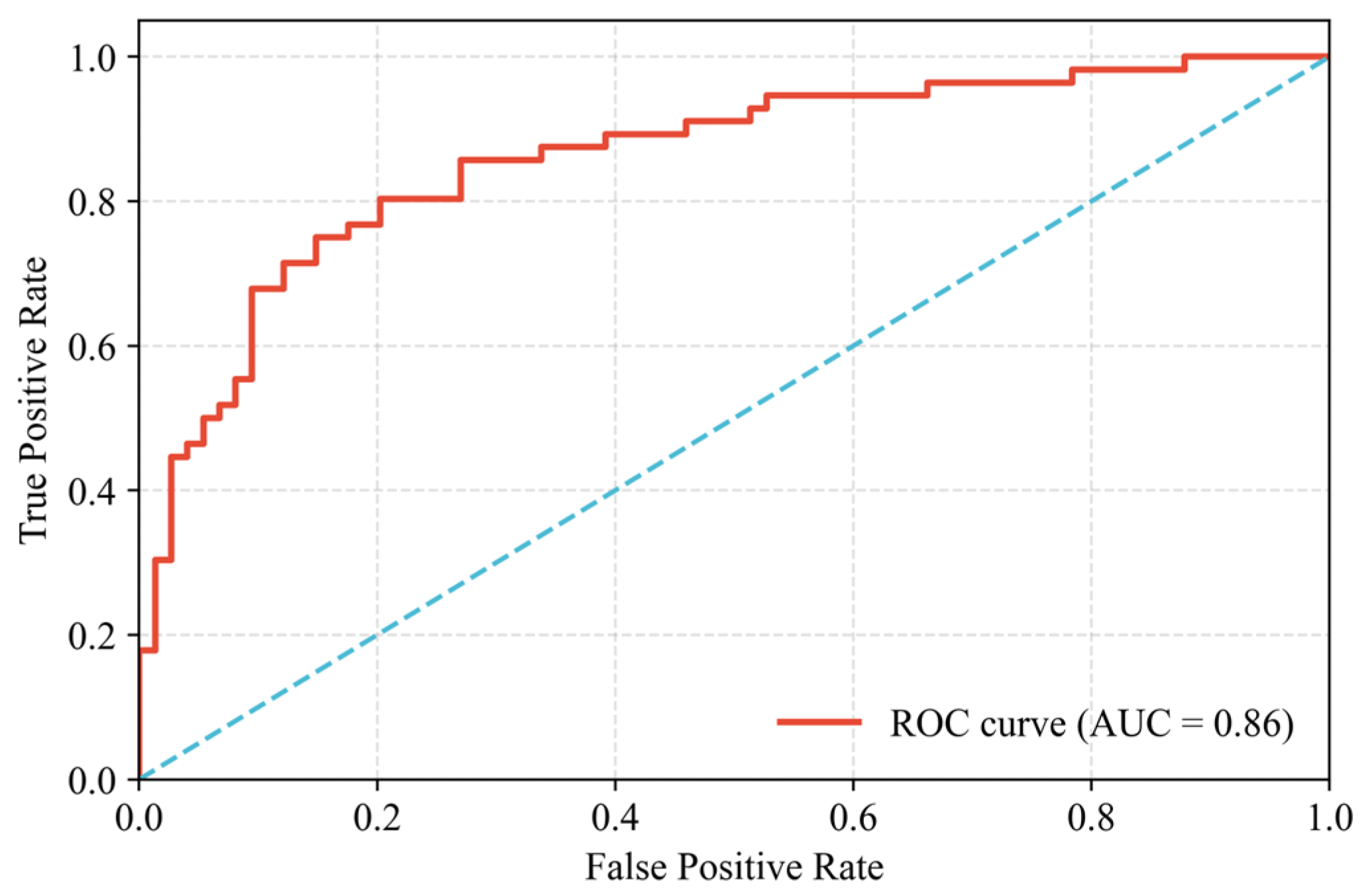
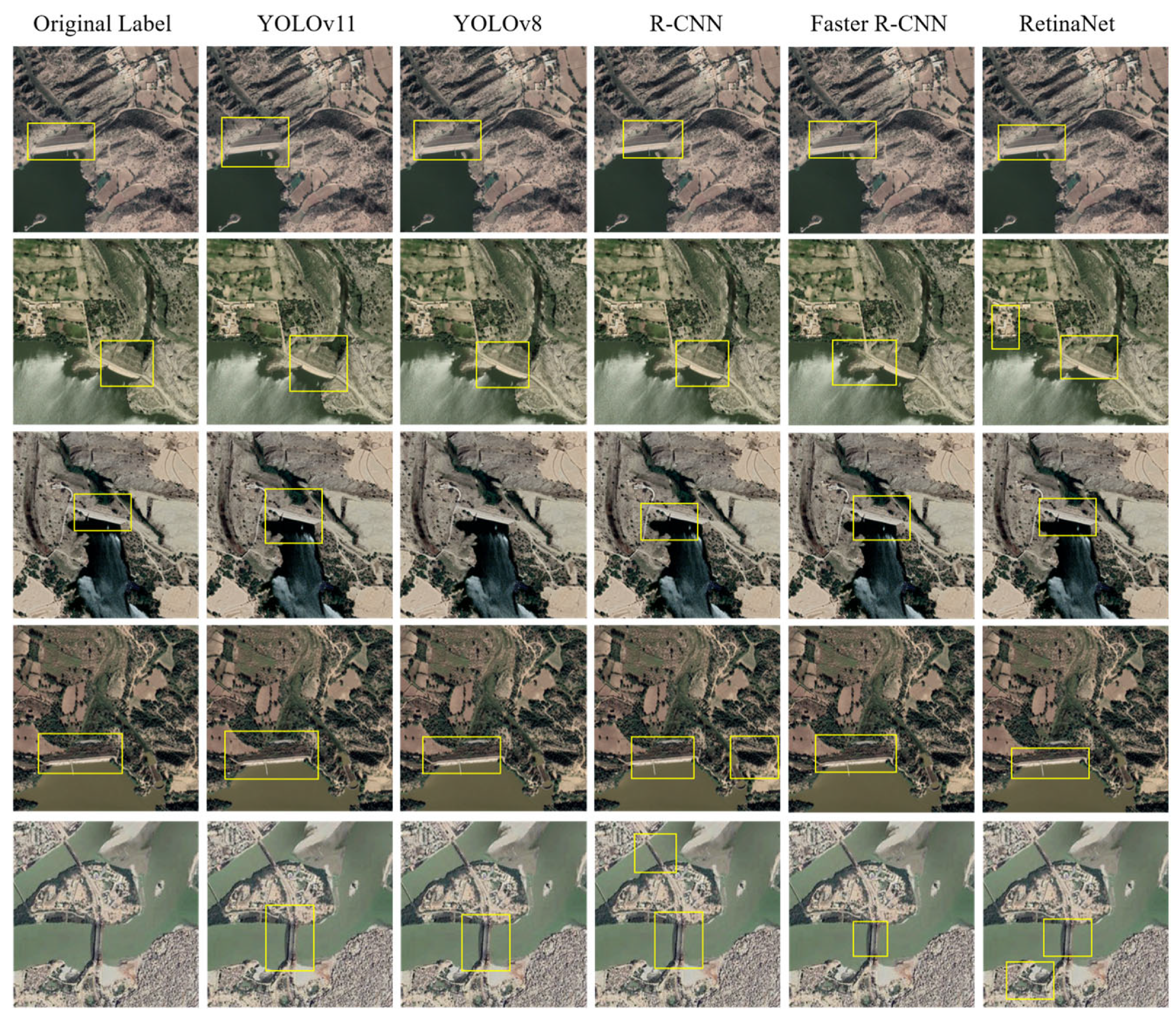
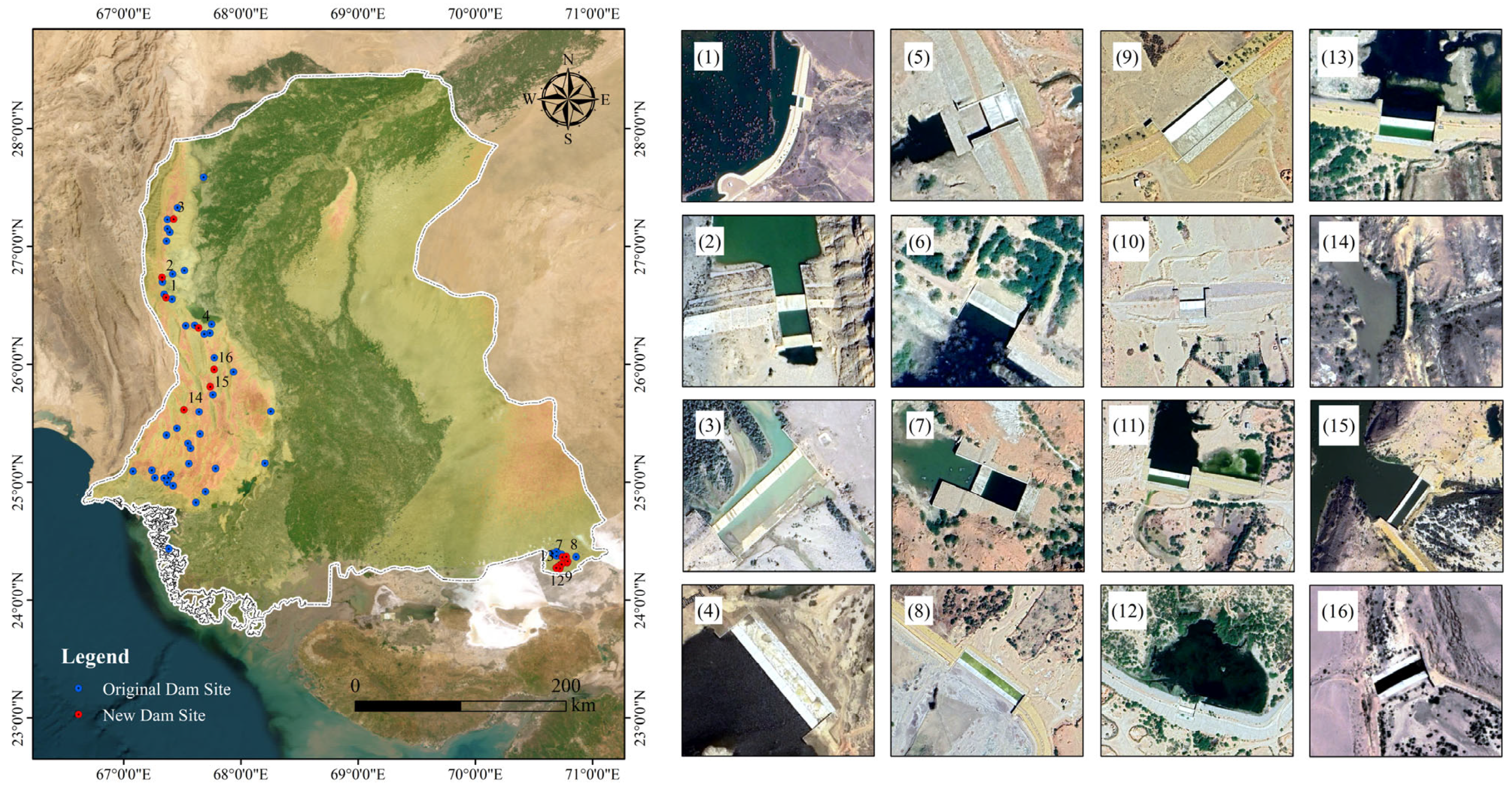
| Class | Train | Validation | Test | Total |
|---|---|---|---|---|
| Dam | 8575 | 1225 | 2450 | 12,250 |
| Models | Precision | Recall | F1_Score | mAP50 |
|---|---|---|---|---|
| YOLOv8 | 0.81 | 0.78 | 0.79 | 0.78 |
| R-CNN | 0.79 | 0.72 | 0.75 | 0.64 |
| Faster R-CNN | 0.81 | 0.76 | 0.78 | 0.67 |
| RetinaNet | 0.76 | 0.70 | 0.73 | 0.59 |
| YOLOv11 | 0.85 | 0.83 | 0.84 | 0.85 |
| Scenario | Precision | Recall | F1_Score | mAP50 | False Positives |
|---|---|---|---|---|---|
| YOLOv11 | 0.67 | 0.70 | 0.68 | 0.64 | 130 |
| RF-YOLOv11 | 0.85 | 0.83 | 0.84 | 0.85 | 31 |
Disclaimer/Publisher’s Note: The statements, opinions and data contained in all publications are solely those of the individual author(s) and contributor(s) and not of MDPI and/or the editor(s). MDPI and/or the editor(s) disclaim responsibility for any injury to people or property resulting from any ideas, methods, instructions or products referred to in the content. |
© 2025 by the authors. Licensee MDPI, Basel, Switzerland. This article is an open access article distributed under the terms and conditions of the Creative Commons Attribution (CC BY) license (https://creativecommons.org/licenses/by/4.0/).
Share and Cite
Qu, C.; Liu, Y.; Wu, Z.; Wang, W. Optimizing Dam Detection in Large Areas: A Hybrid RF-YOLOv11 Framework with Candidate Area Delineation. Sensors 2025, 25, 5507. https://doi.org/10.3390/s25175507
Qu C, Liu Y, Wu Z, Wang W. Optimizing Dam Detection in Large Areas: A Hybrid RF-YOLOv11 Framework with Candidate Area Delineation. Sensors. 2025; 25(17):5507. https://doi.org/10.3390/s25175507
Chicago/Turabian StyleQu, Chenyao, Yifei Liu, Zhimin Wu, and Wei Wang. 2025. "Optimizing Dam Detection in Large Areas: A Hybrid RF-YOLOv11 Framework with Candidate Area Delineation" Sensors 25, no. 17: 5507. https://doi.org/10.3390/s25175507
APA StyleQu, C., Liu, Y., Wu, Z., & Wang, W. (2025). Optimizing Dam Detection in Large Areas: A Hybrid RF-YOLOv11 Framework with Candidate Area Delineation. Sensors, 25(17), 5507. https://doi.org/10.3390/s25175507







